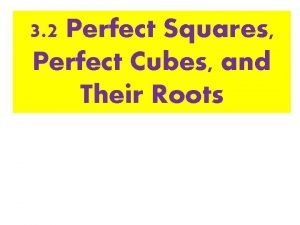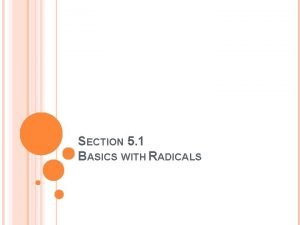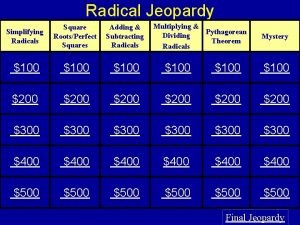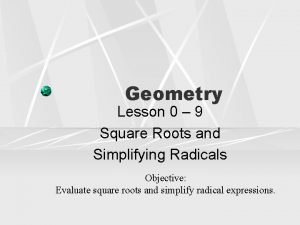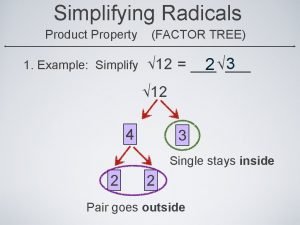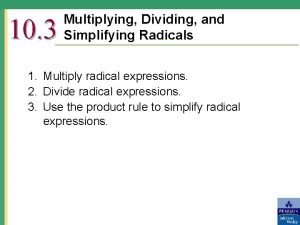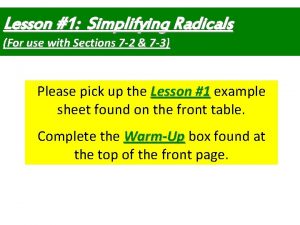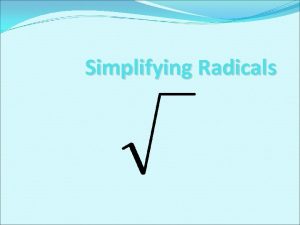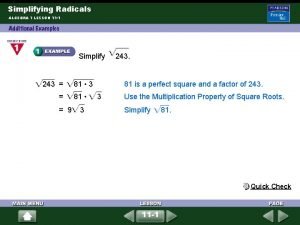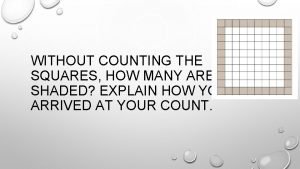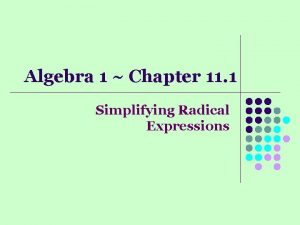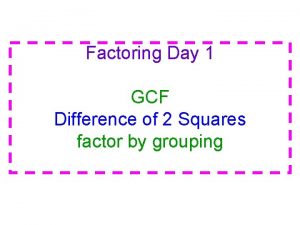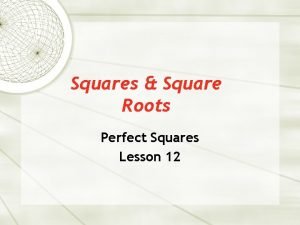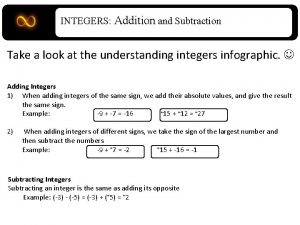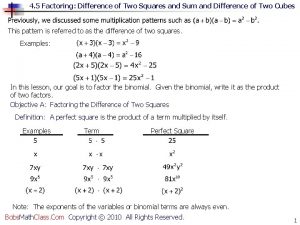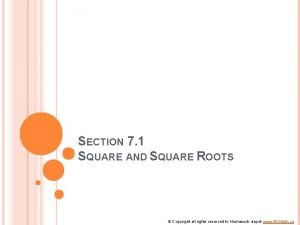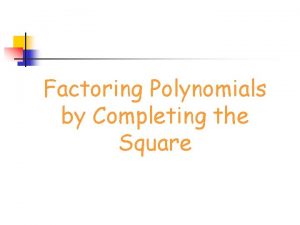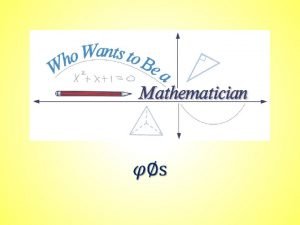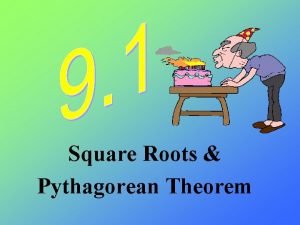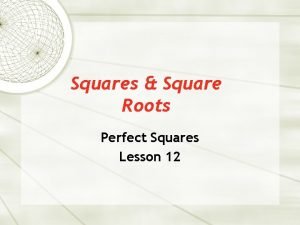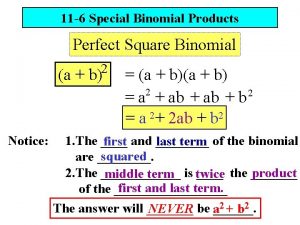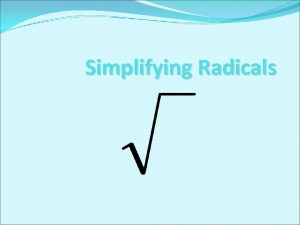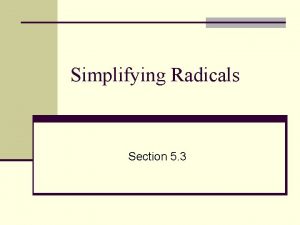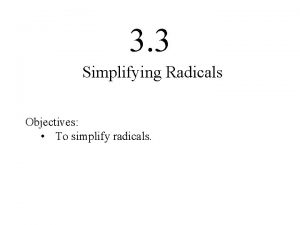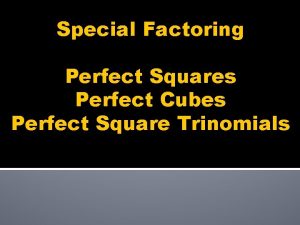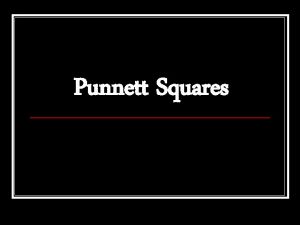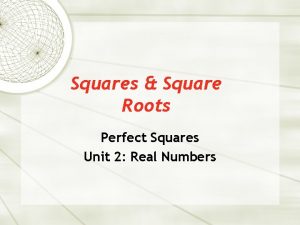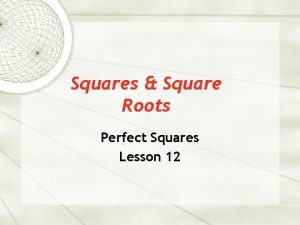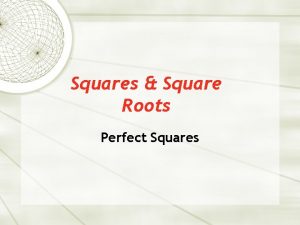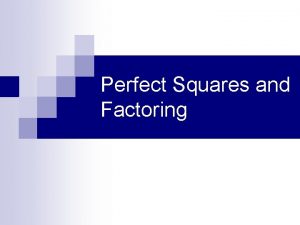Simplifying Radicals Perfect Squares 1 4 9 16



































- Slides: 35

Simplifying Radicals

Perfect Squares 1 4 9 16 25 36 49 64 225 81 100 121 144 169 196 256 289 324 400

=2 =4 =5 = 10 = 12

LEAVE IN RADICAL FORM Perfect Square Factor * Other Factor = = = = =

Simplifying Radicals by Tree Method. Simplify the following. Step one, break the number down into a factor tree. Step two: Circle any pairs. 10 2 2 5

So… which is really just… The pair(s)go outside of the radical sign, but you only use one of them to represent the pair. Any term that is not a pair stays under the radical sign. Thus, the solution is …

Another Example Simplify the following: Step 1: Make a factor tree 10 14 2 So that leaves: Which is: 7 2 5

Your Turn! Simplify the following: 1. 2. 3. 4. 8

LEAVE IN RADICAL FORM = = =

LEAVE IN RADICAL FORM = = =

Adding or Subtracting Radicals To add or subtract square roots you must have like radicands (the number under the radical). Then you add or subtract the coefficients! Sometimes you must simplify first:

Example 1:

Try These

DO NOW

* To multiply radicals: multiply the coefficients and then multiply the radicands and then simplify the remaining radicals.

Radical Product Property ONLY when a≥ 0 and b≥ 0 For Example: Equal


Multiplying Radicals 1. Multiply terms outside the radical together. 2. Multiply terms inside the radical together. 3. Simplify.

Multiplication and Radicals Simplify the expression:

Multiply then simplify

Multiplying Radicals You can multiply using distributive property and FOIL.

Multiply: You try.

Using the Conjugate to Simplify Conjugate Expression Conjugate Product The radical “goes away” every time

To divide radicals: divide the coefficients, divide the radicands if possible, and rationalize the denominator so that no radical remains in the denominator

Radical Quotient Property ONLY when a≥ 0 and b≥ 0 For Example: Equal


Fractions and Radicals Simplify the expressions: There is nothing to simplify because the square root is simplified and every term in the fraction can not be divided by 10. Make sure to simplify the fraction.

Dividing to Simplify Radicals No radicals in the denominator allowed Denominators must be “rationalized. ” Multiply by 1 √ in the form of 3 1 √

Using the Conjugate to Simplify Conjugate Expression Conjugate Product The radical “goes away” every time

Dividing to Simplify Radicals Multiply by 5 1 11 1 conjugate in the form of conjugate

Simplify: You try.

This cannot be divided which leaves the radical in the denominator. We do not leave radicals in the denominator. So we need to rationalize by multiplying the fraction by something so we can eliminate the radical in the denominator. 42 cannot be simplified, so we are finished.

This can be divided which leaves the radical in the denominator. We do not leave radicals in the denominator. So we need to rationalize by multiplying the fraction by something so we can eliminate the radical in the denominator.

This cannot be divided which leaves the radical in the denominator. We do not leave radicals in the denominator. So we need to rationalize by multiplying the fraction by something so we can eliminate the radical in the denominator. Reduce the fraction.

Summary: To ADD and SUBTRACT To MULTIPLY COMBINE LIKE TERMS “Outside” NUMBERS x NUMBERS “Inside” NUMBERS x NUMBERS DISTRIBUTE and FOIL To DIVIDE “Rationalize” denominator using Use conjugate ALWAYS SIMPLIFY AT THE END IF YOU CAN 1
 2744 cube root
2744 cube root 9/16 simplified
9/16 simplified What is an entire radical
What is an entire radical Unlike radicals examples
Unlike radicals examples Simplifying radicals jeopardy
Simplifying radicals jeopardy Lesson 0-9 square roots and simplifying radicals answers
Lesson 0-9 square roots and simplifying radicals answers Simplifying radicals with factor tree
Simplifying radicals with factor tree Rationalizing the denominator worksheet
Rationalizing the denominator worksheet Multiply radical
Multiply radical Simplifying radicals worksheet no variables
Simplifying radicals worksheet no variables Lesson 1: simplifying radicals
Lesson 1: simplifying radicals Unit 7-1 simplifying radicals
Unit 7-1 simplifying radicals Simplify square root of 8
Simplify square root of 8 Multiplying radicals
Multiplying radicals Simplify radical 108
Simplify radical 108 Simplifying radicals quiz
Simplifying radicals quiz 11-3 solving radical equations
11-3 solving radical equations How many squares
How many squares My age
My age He has ha hemos
He has ha hemos Simplifying radical expressions
Simplifying radical expressions 2 squares a day
2 squares a day Square root activity
Square root activity Squares of numbers from 1 to 50
Squares of numbers from 1 to 50 Adding integers examples
Adding integers examples What are the steps in factoring difference of two squares
What are the steps in factoring difference of two squares Copyright
Copyright Factoring non perfect square trinomials
Factoring non perfect square trinomials Square root list
Square root list Perfect squares between 100 and 200
Perfect squares between 100 and 200 Perfect squares 1-1000
Perfect squares 1-1000 Perfect squares
Perfect squares How to factor perfect square trinomials
How to factor perfect square trinomials Pythagorean theorem perfect squares
Pythagorean theorem perfect squares Perfect square activity
Perfect square activity Binomial products
Binomial products
